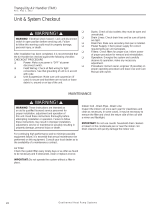
5
IMPORTANT: To prevent internal oxidation and
scaling from occuring, braze all connections with
dry nitrogen flowing through the joints.
4. Wrap the refrigerant lines with pressure sensitive
neoprene or other suitable material especially
where the lines enter the opening in the sheet metal.
NOTE: On horizontal models with a TXV valve, reposition
the sensing bulb to the 4 or 8 o’clock position on the
suction line.
Completing the Installation
1. Check the system for leaks, including the lineset and the
brazed joints. NOTE: Apply a soap and water solution on
each joint or union with a small paintbrush. If bubbling
is observed, the connection is not adequately sealed.
2. Evacuate the system of moisture and non-condensables
to prevent low efficiency operation or damage to the
unit. The suggested range of evacuation is 250 - 500
microns.
3. Charge the system with refrigerant. Please Refer to
the outdoor unit installation manual for additional
charging instructions.
4. Install the coil access door (if removed).
5. Properly dispose of all removed parts.
6. Apply power to the unit.
Condensate Drain
CAUTION:
The coil must be level to ensure proper condensate
drainage. Improper condensate disposal may
result in structural damage, premature equipment
failure, or possible personal injury.
• Methods for disposing of condensate vary according
to local codes. Refer to local codes or authority having
jurisidiction for restrictions and proper condensate
disposal requirements.
• All condensate pans have primary and secondary drain
connections to meet FHA requirements. If the application
is located in or above a living space where damage
may result from condensate overflow, a separate 3/4
inch drain must be provided from the secondary drain
connection and a secondary drain pan must be installed
under the entire unit. Run secondary drain lines to a
place where they are noticeable if used.
• The coil condensate pan is designed with 3/4” NPSC
drain connections. Use a PVC or similar material fitting
to attach the drain line to the pan. NOTE: The fitting
should be hand tightened only. Overtightening may
crack the drain pan and cause condensate to leak.
• The drain pan MUST be drained with field supplied
tubing and looped to form a trap.
IMPORTANT: Failure to install a trap may result in
condensation overflowing the drain pan, resulting in
substantial water damage to surrounding area.
• Prime the trap with water. Insulate the drain if it is located
in an unconditioned space, and test the condensate line
for leaks. Consult local codes for additional restrictions
or precautions.
• Route the lines to a suitable drain, avoiding sharp bends
and pinching of the lines. The drain should maintain a
minimum horizontal slope in the direction of discharge
of no less than 1” vertical for every 10 ft of horizontal
run.
• During system checkout, inspect the drain line and
connections to verify proper condensate drainage.
Air Filter
Air filters are not supplied as an integral part of this
coil; however, an air filter kit is available. Refer to the
Replacement Parts List for available part numbers.
The filter must be installed upstream of the coil and
inspected frequently. When the filter becomes clogged
with dust or lint, it should be replaced (disposable type)
or cleaned (washable type). It is recommended that filters
be inspected and replaced at least twice during the year.
Generally it is best to replace or clean the filters at the
start of each heating and cooling season.
MAINTENANCE & SERVICE
WARNING:
ELECTRICAL SHOCK, FIRE OR EXPLOSION
HAZARD
Failure to follow safety warnings exactly could
result in serious injury or property damage.
Improper servicing could result in dangerous
operation, serious injury, death or property
damage.
• Before servicing, disconnect all electrical power
to the furnace or air handler.
• When servicing controls, label all wires prior
to disconnecting. Reconnect wires correctly.
• Verify proper operation after servicing.
CAUTION:
Do not operate the system without a suitable filter
in the return air duct system. Always replace the
filter with the same size and type.
To ensure optimum performance and to minimize possible
equipment failure, the following maintenance tasks should
be performed periodically on this equipment:
1. The air filter installed with the system should be checked
and cleaned or replaced twice per year.
2. Check the coil, drain pan, and condensate drain line
for cleanliness at the start of each heating and cooling
season. Clean as needed.









